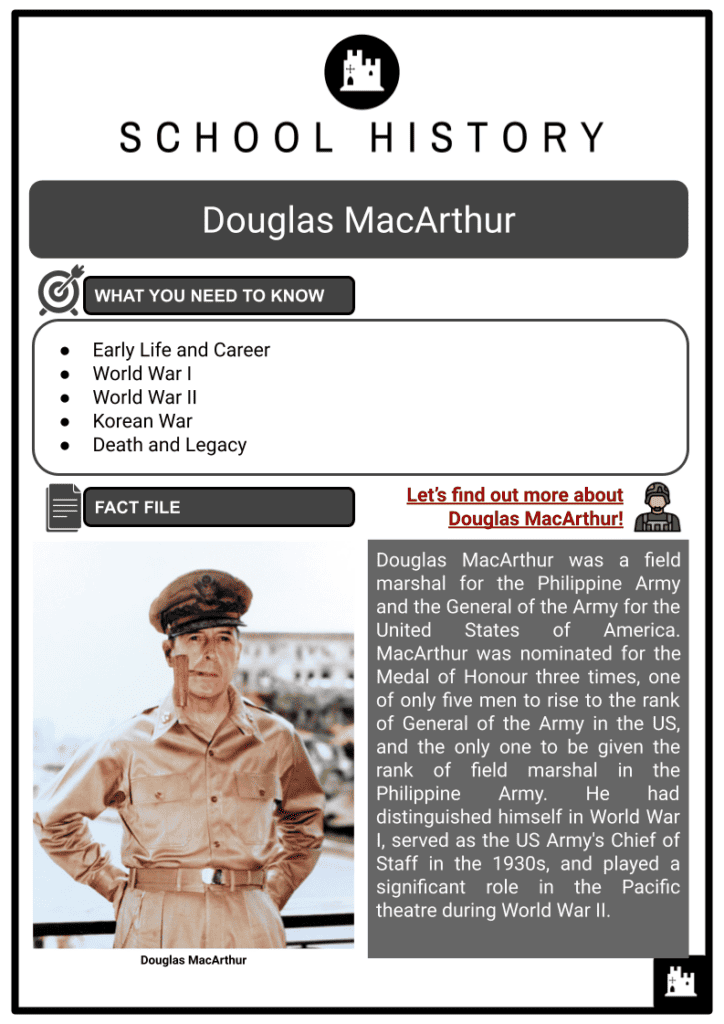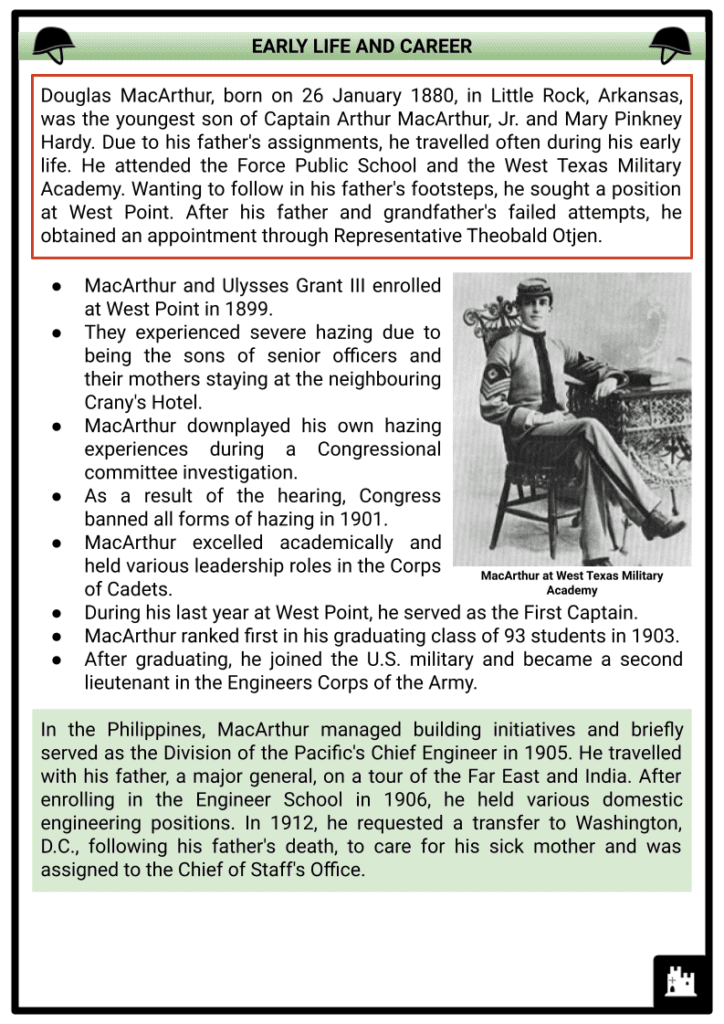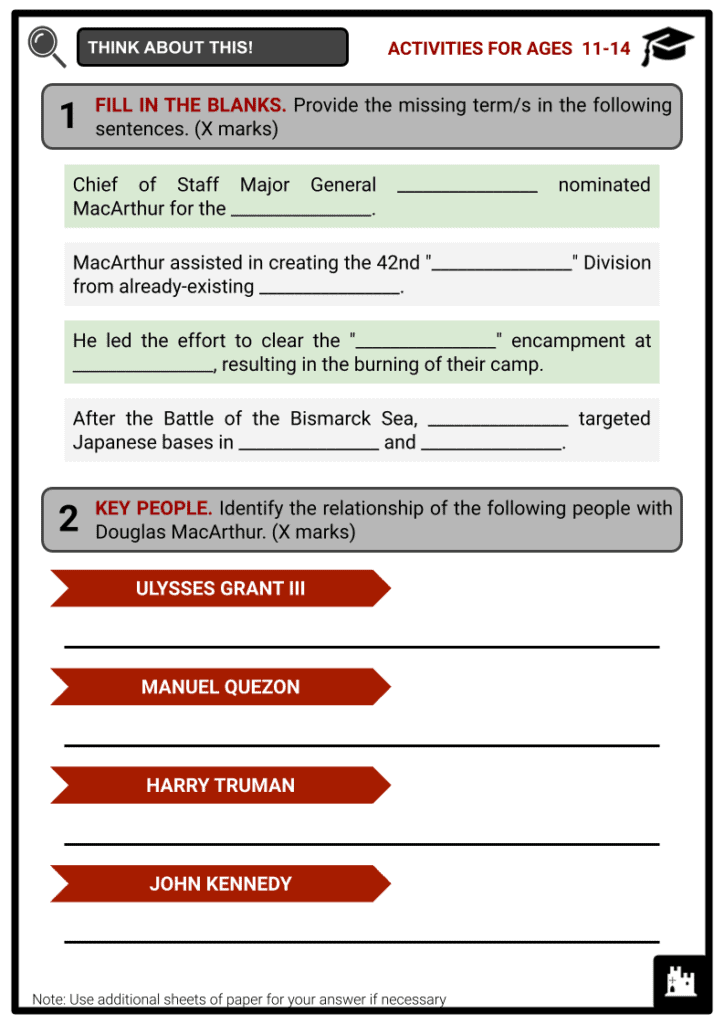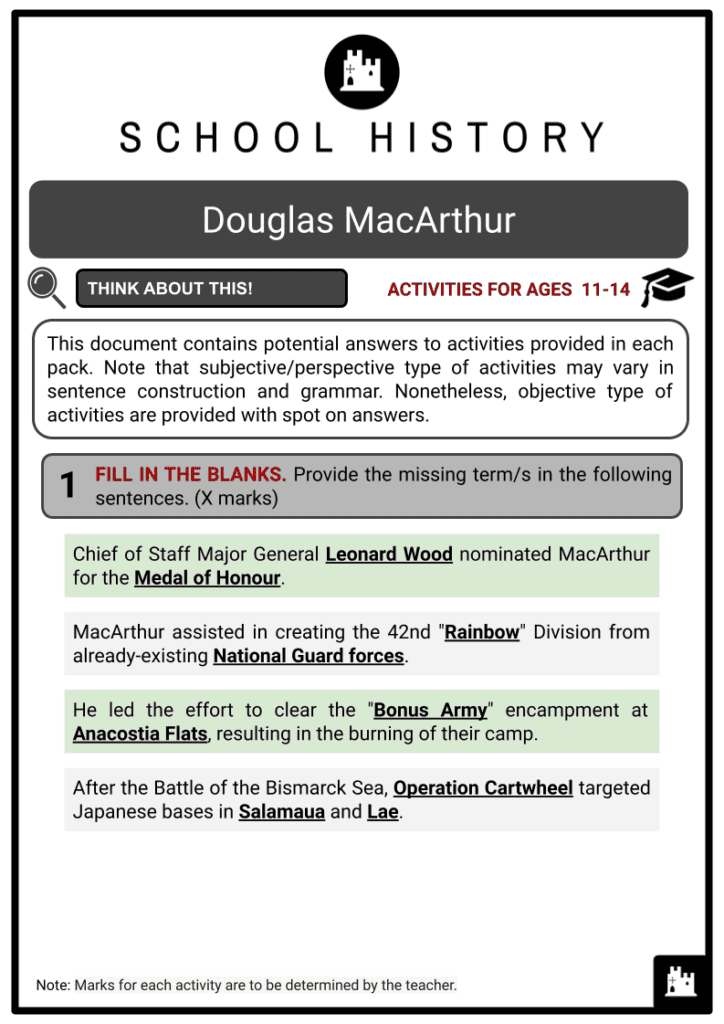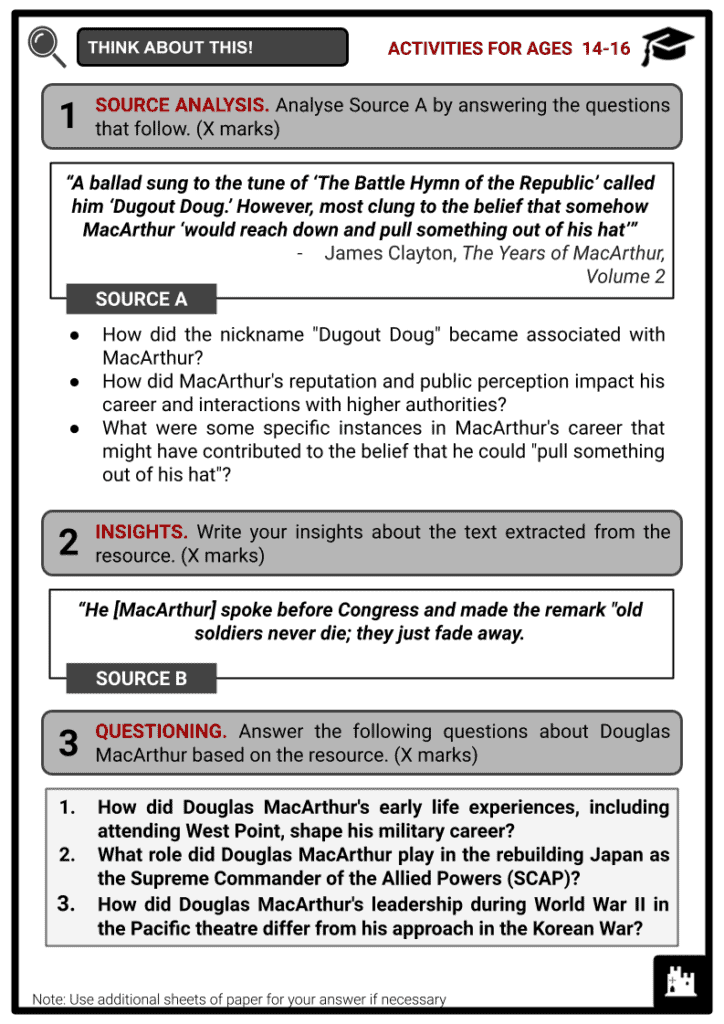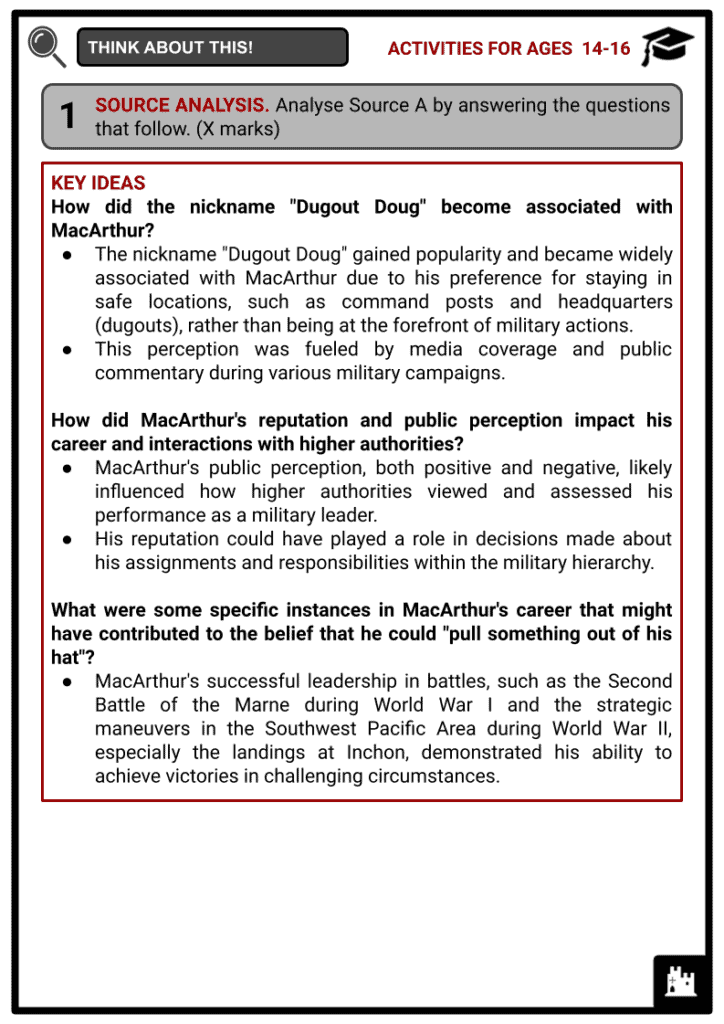Douglas MacArthur Worksheets
Do you want to save dozens of hours in time? Get your evenings and weekends back? Be able to teach about Douglas MacArthur to your students?
Our worksheet bundle includes a fact file and printable worksheets and student activities. Perfect for both the classroom and homeschooling!
Summary
- Early Life and Career
- World War I
- World War II
- Korean War
- Death and Legacy
Key Facts And Information
Let’s find out more about Douglas MacArthur!
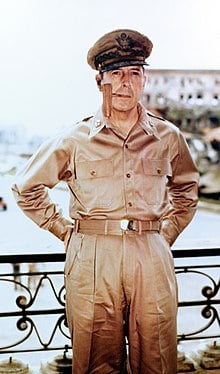
Douglas MacArthur was a field marshal for the Philippine Army and the General of the Army for the United States of America. MacArthur was nominated for the Medal of Honour three times, one of only five men to rise to the rank of General of the Army in the US, and the only one to be given the rank of field marshal in the Philippine Army. He had distinguished himself in World War I, served as the US Army's Chief of Staff in the 1930s, and played a significant role in the Pacific theatre during World War II.
EARLY LIFE AND CAREER
- Douglas MacArthur, born on 26 January 1880, in Little Rock, Arkansas, was the youngest son of Captain Arthur MacArthur, Jr. and Mary Pinkney Hardy. Due to his father's assignments, he travelled often during his early life. He attended the Force Public School and the West Texas Military Academy. Wanting to follow in his father's footsteps, he sought a position at West Point. After his father and grandfather's failed attempts, he obtained an appointment through Representative Theobald Otjen.
- MacArthur and Ulysses Grant III enrolled at West Point in 1899.
- They experienced severe hazing due to being the sons of senior officers and their mothers staying at the neighbouring Crany's Hotel.
- MacArthur downplayed his own hazing experiences during a Congressional committee investigation.
- As a result of the hearing, Congress banned all forms of hazing in 1901.
- MacArthur excelled academically and held various leadership roles in the Corps of Cadets.
- During his last year at West Point, he served as the First Captain.
- MacArthur ranked first in his graduating class of 93 students in 1903.
- After graduating, he joined the U.S. military and became a second lieutenant in the Engineers Corps of the Army.
- In the Philippines, MacArthur managed building initiatives and briefly served as the Division of the Pacific's Chief Engineer in 1905. He travelled with his father, a major general, on a tour of the Far East and India. After enrolling in the Engineer School in 1906, he held various domestic engineering positions. In 1912, he requested a transfer to Washington, D.C., following his father's death, to care for his sick mother and was assigned to the Chief of Staff's Office.
- Due to tensions with Mexico, President Woodrow Wilson ordered the American forces to seize Veracruz at the beginning of 1914.
- On 1 May, a delegation from the headquarters was dispatched to Veracruz, including MacArthur.
- He helped a small group locate the locomotives they needed for their out-of-town march.
- Once MacArthur and his men discovered the locomotives in Alvarado, they had to battle their way back to the American lines.
- For successfully delivering the locomotives, Chief of Staff Major General Leonard Wood nominated MacArthur for the Medal of Honour.
- The award-making board rejected Brigadier General Frederick Funston's suggestion despite his support.
- The operation was carried out without the commanding general's knowledge, and the board made its judgement out of worry that it might inspire staff officers to do similar measures in the future.
WORLD WAR I
- When MacArthur returned to Washington, he was promoted to major on 11 December and given the Office of Information the next year. In April 1917, when the United States entered World War I, MacArthur assisted in creating the 42nd "Rainbow" Division from already-existing National Guard forces. The 42nd's units were purposefully chosen from as many states as possible in order to boost morale. When describing the idea, MacArthur said that the division's membership "will stretch over the whole country like a rainbow."
- MacArthur became the chief of staff for the 42nd Division after being promoted to colonel.
- He earned a Silver Star during a French trench raid in February 1918.
- In March 1918, he received a Distinguished Service Cross for his leadership in a trench raid with the 168th Infantry Regiment.
- Promoted to brigadier general in June 1918, he became the youngest general in the American Expeditionary Force.
- During the Second Battle of the Marne, he earned three more Silver Stars and took command of the 84th Infantry Brigade.
- In September, he received two additional Silver Stars for his leadership during the Battle of Saint-Mihiel.
- He was wounded in October during the Meuse-Argonne Offensive but received a second Distinguished Service Cross instead of the Medal of Honor.
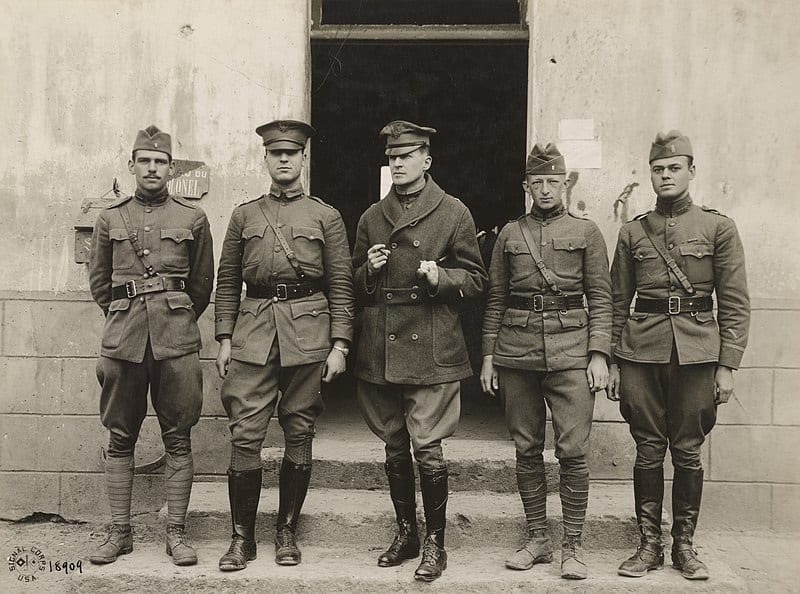
MacArthur in his WWI Uniform (centre) - MacArthur led his brigade through the final campaigns of the war and briefly commanded the 42nd Division.
- After serving in occupation duty in the Rhineland, he returned to the United States in April 1919.
- MacArthur retained his brigadier general rank by becoming West Point's superintendent, a position he held from June 1919 to 1922. He improved the academic curriculum, reduced hazing, strengthened the honour code, and expanded athletics, facing resistance but ultimately succeeding in implementing his changes.
- In October 1922, MacArthur graduated from the academy and took command of Manila's Military District, where he befriended influential Filipinos like Manuel L. Quezon and modernised the local military structure. He was promoted to major general on 17 January 1925. Later, he assumed command of the III Corps Area, with headquarters in Baltimore. During this time, he was involved in Brigadier General Billy Mitchell's court-martial, adding to his responsibilities.
- After a two-year assignment in the Philippines, MacArthur returned to the U.S. in 1930 and briefly commanded IX Corps Area in San Francisco.
- Despite his young age, he was appointed as the Chief of Staff of the U.S. Army in November 1930.
- During the Great Depression, MacArthur worked to prevent drastic cuts in the Army's manpower, but had to close more than 50 bases.
- He focused on modernising and updating the Army's war plans during his tenure.
- MacArthur negotiated the MacArthur-Pratt agreement with Admiral William V. Pratt, clarifying aviation responsibilities between the Army and Navy.
- In 1932, his reputation suffered when he led the effort to clear the "Bonus Army" encampment at Anacostia Flats, resulting in the burning of their camp.
- Despite political differences, President Franklin D. Roosevelt extended MacArthur's term as Chief of Staff.
- Under MacArthur's leadership, the U.S. Army played a significant role in overseeing the Civilian Conservation Corps.
- After being Chief of Staff for the Philippines until 1935, MacArthur was convinced by Manuel Quezon to create the Philippine Army. He became a field marshal for the Commonwealth of the Philippines, advising their military. However, they faced challenges with outdated equipment. MacArthur lobbied Washington for better resources, but most requests were denied. In 1937, he remained as Quezon's counsellor. Eisenhower left two years later, and Lieutenant Colonel Richard Sutherland became MacArthur's chief of staff.
WORLD WAR II
- In July 1941, Roosevelt activated General Douglas MacArthur to command the US Army Forces in the Far East as tensions with Japan escalated. Additional troops and supplies were sent to the Philippines for defence. After the Pearl Harbor attack on 8 December 1941, the Japanese struck Clark and Iba Fields, significantly damaging MacArthur's air force. Japanese troops landed at Lingayen Gulf on 21 December and MacArthur's forces struggled to resist their advance. The Allied forces created a defensive line on the Bataan Peninsula and followed prewar plans by withdrawing from Manila.
- In April 1942, MacArthur took command of the Allied Forces in the Southwest Pacific Area with bases in Australia. He led successful operations in New Guinea, securing victories at Milne Bay, Buna-Gona, and Wau in 1942-1943.
- After the Battle of the Bismarck Sea, Operation Cartwheel targeted Japanese bases in Salamaua and Lae, which were captured in September 1943. MacArthur's forces also landed in Hollandia and Aitape in April 1944. Despite ongoing fighting in New Guinea, his main priority was planning the invasion of the Philippines. His leadership in the Southwest Pacific Area played a crucial role in the Allies' campaign against Japan.
- In mid-1944, MacArthur presented his ideas for liberating the Philippines during a meeting with President Roosevelt and Admiral Nimitz.
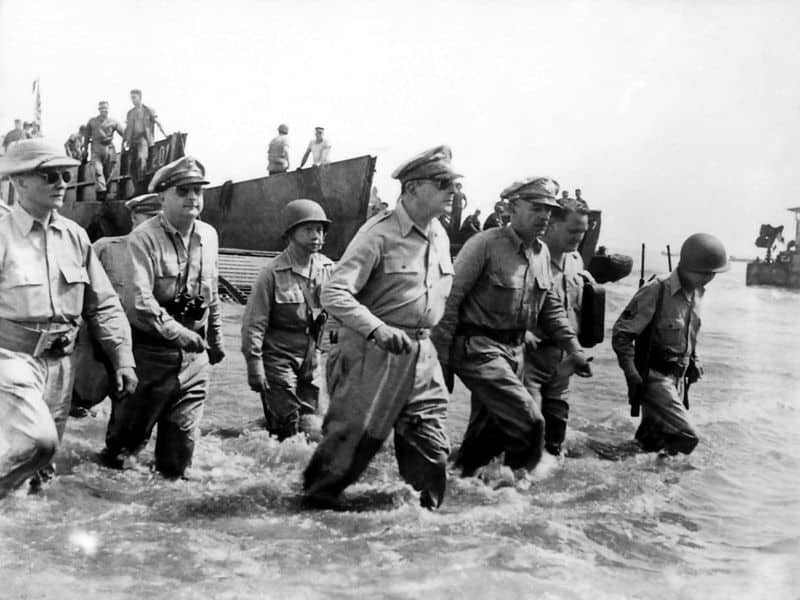
MacArthur returning to the Philippines - On 20 October 1944, MacArthur oversaw the Allied landings on Leyte, famously declaring "I have returned" upon coming ashore.
- While the Battle of Leyte Gulf unfolded, Allied troops faced challenges on Leyte due to heavy monsoons, continuing until year-end.
- In December 1944, MacArthur was promoted to General of the Army, becoming the senior Pacific commander.
- On 9 January 1945, he launched the invasion of Luzon, with battles in Manila lasting until March 3.
- From February to July, MacArthur's Eighth Army executed 52 landings to liberate the southern Philippines.
- In May, Australian forces under his command attacked Japanese positions in Borneo.
- As preparations for the invasion of Japan began, MacArthur's candidacy for overall commander was considered. However, the Soviet Union's declaration of war and the use of atomic bombs made it irrelevant. On 29 August 1945, he was appointed Supreme Commander of the Allied Powers (SCAP) in Japan, overseeing the nation's occupation. The surrender was signed on 2 September aboard the USS Missouri.
- MacArthur implemented political reforms to establish democracy in postwar Japan.
- He drafted Japan's new constitution, known as “Postwar Constitution” or “MacArthur Constitution” effective in 1947.
- The constitution transformed Japan into a parliamentary democracy with a constitutional monarchy.
- It introduced universal suffrage and protected individual rights and freedoms. It also renounced war and aggressive military actions.
- MacArthur's reforms led to the creation of the National Diet in 1946, Japan's representative legislature.
- To achieve a seamless transition and win the support of the Japanese people, General Douglas MacArthur understood the importance of working with the current Japanese administration and Emperor Hirohito and kept him on the throne with less privileges. They built a working connection that aided the reconstruction operations through repeated meetings with Hirohito. Through the deconstruction of militaristic and imperialist components of the government and society, MacArthur's reforms sought to democratise Japan.
- MacArthur dismantled military and imperialistic elements in Japan to democratise the nation.
- He oversaw the drafting of Japan's new constitution, including Article 9, which prohibited a traditional military.
- Land reforms were introduced, dividing large estates and providing land to tenant farmers.
- MacArthur advocated for women's rights and gender equality, granting them the right to vote.
- He led comprehensive economic reforms that contributed to Japan's postwar economic growth and transformation.
KOREAN WAR
- The Korean War began on 25 June 1950, when North Korea attacked South Korea. The new United Nations immediately denounced North Korea's aggressiveness and approved the formation of a military force to support South Korea. Aso, it instructed the US government to choose the chief commander of the force. The Joint Chiefs of Staff decided to name MacArthur the Commander-in-Chief of the United Nations Command at their meeting. He immediately started channelling help to South Korea from the Dai Ichi Life Insurance Building in Tokyo and dispatched Lieutenant General Walton Walker's Eighth Army to Korea.
- South Koreans and the Eighth Army were pushed back by North Koreans, taking refuge in the Pusan Perimeter.
- Reinforcements arrived, and MacArthur prepared offensive actions against the North Koreans.
- MacArthur proposed an amphibious strike at Inchon to catch the enemy off guard and cut their supply lines.
- Despite initial scepticism, the landings at Inchon on 15 September were successful, with UN troops capturing Seoul on 25 September.
- The North Koreans retreated beyond the 38th Parallel as UN forces entered North Korea.
- China warned of intervention if MacArthur's troops reached the Yalu River.
- In October, President Harry Truman and MacArthur met on Wake Island, where MacArthur minimised the Chinese threat and hoped for American forces' return by Christmas. Chinese forces attacked in late October, driving UN troops south and delaying stabilisation beyond Seoul. In early 1951, MacArthur's counteroffensive recaptured Seoul and advanced past the 38th Parallel. Disagreements with Truman led him to demand China's defeat by 24 March. On 5 April a critical letter from MacArthur to Truman was revealed, and on 11 April Truman removed him from command, appointing General Ridgway as his replacement.
DEATH AND LEGACY
- In the US, there was a raging controversy about MacArthur's dismissal. When he arrived home, he was feted as a hero and given ticker tape parades in New York and San Francisco. In between these incidents, on 19 April he spoke before Congress and made the remark "old soldiers never die; they just fade away."
- MacArthur was a popular figure and a potential candidate for the 1952 Republican presidential nomination.
- However, he had no interest in pursuing a political career, and his popularity declined somewhat after a Congressional investigation supported Truman's decision to remove him from command, making him a less attractive candidate.
- After retiring, MacArthur and his wife Jean settled in New York City, where he engaged in business activities and wrote his memoirs.
- In 1961, President John F. Kennedy consulted MacArthur, seeking his advice on Vietnam. MacArthur warned against a military buildup in the region.
- MacArthur passed away on 5 April 1964, at Walter Reed National Military Medical Center in Bethesda, Maryland. He received a state funeral and was buried at the MacArthur Memorial in Norfolk, Virginia.
Image Sources
Frequently Asked Questions
- Who was Douglas MacArthur?
Douglas MacArthur was a prominent American military leader who served as a general in the United States Army. He was born on 26 January 1880 and played a significant role in several major military conflicts, including WWI, WWII, and the Korean War.
- What is Douglas MacArthur famous for?
MacArthur is best known for his command in the Pacific during World War II, where he implemented successful island-hopping strategies against Japanese forces and recaptured territories from the enemy.
- What was the "I shall return" statement attributed to MacArthur?
After the Japanese invaded the Philippines during World War II, MacArthur was forced to leave the country. Before departing, he made the famous statement "I shall return" to rally the Filipino and American forces, promising to return and liberate the Philippines from Japanese occupation. With the help of the Filipino guerilla, he fulfilled this promise when he returned to the Philippines in 1944.

